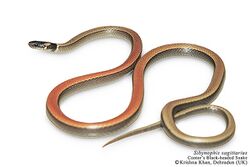Biology:Sibynophis sagittarius
| Sibynophis sagittarius | |
|---|---|

| |
| Specimen from Uttarakhand | |
| Scientific classification | |
| Domain: | Eukaryota |
| Kingdom: | Animalia |
| Phylum: | Chordata |
| Class: | Reptilia |
| Order: | Squamata |
| Suborder: | Serpentes |
| Family: | Colubridae |
| Genus: | Sibynophis |
| Species: | S. sagittarius
|
| Binomial name | |
| Sibynophis sagittarius (Cantor, 1839)
| |
| Synonyms | |
Sibynophis sagittarius, commonly known as Cantor's black-headed snake after Theodore Cantor,[3][4] is a species of snake endemic to South Asia.[2]
Geographic range
It is found in central and northeastern India , Bhutan, Nepal, and Pakistan .[2] It is uncertain whether the species occurs or has occurred in Bangladesh.[5]
Description
Adults may attain 28 cm (11 inches) in total length, with a tail 6 cm (2⅜ inches) long.
As the common name implies, the dorsal surface of the head, including the nape of the neck, is black or dark brown, followed by a thin yellow nuchal collar. Also, there are two large elongate yellowish spots, one on each side of the back of the head. The upper surface of the body is pale brown, and the sides of the body are darker brown or gray. On each flank there is a thin black stripe separating the differently colored areas. A series of small black dots, widely separated, run down the vertebral row of dorsal scales. The underside is yellow, with a black dot at each outer end of every ventral.
The smooth dorsal scales, which lack apical pits, are arranged in 17 rows. Ventrals 205–228; anal plate divided; subcaudals 56–70, divided (paired).[6]
Habitat
Sibynophis sagittarius is found in forests.[4]
Behavior
It is not arboreal, but rather hunts by day on the forest floor.[4]
Diet
It feeds on insects, frogs, skinks, and snakes.[4]
Reproduction
An oviparous species, it lays a clutch of as many as six eggs.[4]
References
- ↑ Boulenger, 1893, p. 187.
- ↑ 2.0 2.1 2.2 Sibynophis sagittarius at the Reptarium.cz Reptile Database. Accessed 14 January 2020.
- ↑ Beolens, B.; Watkins, M.; Grayson, M. (2011). The Eponym Dictionary of Reptiles. Johns Hopkins University Press. p. 47. ISBN 978-1-4214-0135-5. https://books.google.com/books?id=3ovZoFyLhzkC&pg=PA47. Retrieved 9 June 2019.
- ↑ 4.0 4.1 4.2 4.3 4.4 Das, Indraneil. 2002. A Photographic Guide to Snakes and Other Reptiles of India. Ralph Curtis Books. Sanibel Island, Florida. 144 pp. ISBN:0-88359-056-5 (Sibynophis sagittaria [sic], p. 45.)
- ↑ "Sibynopis sagittaricus". Snakes of Bangladesh. http://www.snakebd.com/. Retrieved 14 January 2020.
- ↑ Boulenger, G.A. 1893. Catalogue of the Snakes in the British Museum (Natural History). Volume I., Containing the Families...Colubridæ Aglyphæ, Part. Trustees of the British Museum (Natural History). London. xiii + 448 pp. + Plates I.-XXVIII. (Polyodontophis sagittarius, pp. 181, 187-188.)
Further reading
- Cantor, T. 1839. Spicilegium Serpentium Indicorum [second part]. Proc. Zool. Soc. London 1839: 49-55.
- Captain, A.; D. J. Gower, P. David & A. M. Bauer 2004 Taxonomic status of the colubrid snake Sibynophis subpunctatus (Dumeril, Bibron & Dumeril, 1854). Hamadryad 28 (1&2): 90-94
- Das, I. & Palden, J. 2000 A herpetological collection from Bhutan, with new country records. Herpetological Review 31 (4): 256-258
Wikidata ☰ Q941348 entry

